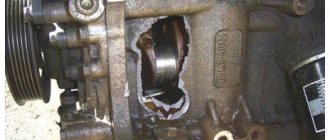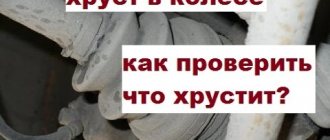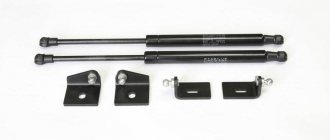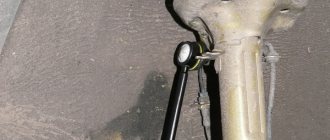The appearance of knocks and clicks when turning the steering wheel is a fairly common problem, and it can happen to both a well-worn car and a brand new one recently received at the dealership.
However, you can identify the source of the sound yourself, without resorting to the services of a service station, which will allow you to save a little, and if you also have certain repair skills, then eliminating the malfunction may cost only the cost of spare parts, and even then not always.
But first things first.
What are the possible steering problems?
Practice shows that the most common and characteristic malfunction is wear of the ball joints of the tie rod ends.
But besides this, there are other problems:
- Deterioration (wear) of rack and pinion mechanism elements.
- Violation of the tightness of connections, hoses and the system as a whole.
- Worn or defective steering shaft bearings.
In cars that are equipped with power steering, there may also be problems with the power steering:
- System clogged.
- Destruction or wear of the vane pump shaft bearing.
- Loss of tightness of connections and hoses.
- Weak drive belt tension.
- Low level or oil leak in the expansion tank.
A fairly common problem among motorists is when a knocking, clicking or crunching sound is heard when turning the steering wheel. It may knock constantly, or maybe only after the car has been parked for a long time. Such a nuisance can happen even to those motorists who monitor the condition of the car and replace worn parts in a timely manner. You should take this symptom seriously and fix the problem as soon as possible.
On video: Knock when turning the steering wheel - CV joint or tri-thorn - grease has leaked
What is the extent of the driver’s alertness when he hears clanking. Only the consequences of knocking hydraulic compensators in the engine are not so dangerous. As for the rest... How do you feel about loss of control in a dense stream of cars or a torn off wheel that is rapidly ahead of the car. There is only one recipe for preventing such terrible things: if you hear tapping, look for the reason. If you want to speed up your search, cut off the main part of the chassis connections without replacing the parts with new ones. How to do this is the subject of further discussion.
Why is the power steering humming and how to fix it
Despite the apparent simplicity of the design of the power steering, this system has a rather complex operating principle. It is precisely an auxiliary element of the steering, and if it fails, complete failure of the steering wheel will not occur, but it will become more difficult to control the car. It is especially dangerous when the power steering stops working while the car is moving, and it is difficult for the driver to instantly get used to the “heaviness” of turning the steering wheel, which is caused by the reduced maneuverability of the car.
If the power steering hums when turning, there are several reasons for this:
- Reduced power steering fluid level. If the driver does not control the fluid level in the power steering, the problem with the appearance of extraneous sounds when the steering wheel rotates may arise precisely because of its low level. In such a situation, you need to replace the fluid in the system and carry out diagnostics, determining why its level has decreased. Most often, power steering oil leaks due to problems with the rack or pump;
- Low quality fluid in the power steering reservoir. There are consumables for cars that you cannot skimp on, and hydraulic booster oil is one of them. Its cost is not so high that you should choose the cheapest options for replacement, and saving on consumable fluid can result in serious system breakdowns that will require the replacement of expensive parts.
If the oil in the hydraulic power steering has exhausted its service life, it should be replaced. Replacing a high-quality fluid is required approximately once every two years (or every 70-80 thousand mileage). There is a household method for analyzing power steering fluid to determine its suitability. To find out if it needs replacement, unscrew the cap of the power steering reservoir and use a syringe (or pipette) to draw out some of the oil that is in it. Next, drop it onto white paper and look at the color. “Clean” power steering fluid should not be black or brown. Acceptable colors are: burgundy, raspberry or red. Be sure to check the smell of the power steering fluid; it should not smell like burnt rubber.
Faults related to the steering rack. One of the most unpleasant problems, due to which the power steering may begin to hum when turning the steering wheel. If the fault lies in the rack, you will need to have the rack and power steering diagnosed at a service center. In some situations, an expensive steering rack replacement may be required. The hydraulic booster drive belt is poorly tensioned. If the power steering belt is loose or very worn, a hum may occur when the steering wheel is turned. In such a situation, the driver can independently purchase a new belt and replace it;
Air entering the power steering system. There are two common reasons why air can get into the system: ingress during fluid replacement and air leakage through loosely connected system components. When such a problem occurs, it is necessary to discover its cause and eliminate it. After this, it is necessary to flush the power steering system, change the oil to a new one and properly bleed the system so that there is no air left in it
Please note that when air enters the power steering, the fluid in the reservoir begins to foam.
Damage to the power steering pump. This fault is easier to identify than others.
When the power steering pump breaks, the system actually stops working, which is why the steering wheel becomes “stiff”, along with this, a hum begins to appear when turning the steering wheel. Most often, problems with the pump occur due to a malfunction of the impeller, bearing or seals. Repair of the power steering pump is performed extremely rarely, and if it fails, the part will need to be replaced.
Most of the reasons that lead to a humming noise in the power steering when turning can be diagnosed and corrected independently. However, it is better not to let the situation lead to serious problems, and to operate the system correctly.
We have a knocking sound when the steering wheel is rocking in place
The most vulnerable connection is the ball joints in the tie rod ends. Inspect them out of turn. The remaining pairings are tested in order:
- Electric power steering – mounting bracket (pressure bolts are loose).
- Emergency folding system (on older machines).
- Cardan between the rack and the column.
- Rail.
- Rods are a rack and pinion mechanism.
Some nodes can be checked in alternative ways:
- Rod ends. Jack up the wheel, grab it at the 3 and 9 o'clock positions and rock it from side to side. There should be no backlash or sounds. Diagnose both sides one by one.
- A system that is triggered in case of an accident. Press the steering wheel down and jerk it left and right. If the noise stops, the cause has been found.
- Kardanchik. A slight wear in the needle bearing is indicated by a knocking sound when turning the steering wheel in motion; on a straight line there is silence.
- Rail. If when driving it knocks only on a straight line, but not when turning and turning, the middle position of the gear is worn out. For replacement.
Advice! Do not tighten a worn rack. The play will stop, but in extreme positions the steering wheel will rotate tighter. Its arbitrary return to the zero position will become impossible.
Quiet in place: knocking only when turning the steering wheel while driving
If it is not a cardan shaft, a rack, or the consequences of flushing the internal combustion engine with dimexide, feel free to inspect the suspension. Anything can tap:
- Racks.
- Support bearings.
- Ball joints.
- Anti-roll bar.
- Wheel bearings.
Most parts are checked with the vehicle stationary:
- "Supports". Ask an assistant to turn the steering wheel while you put your hand on either the strut rod or the spring. Extraneous crunches and play indicate bearing failure.
- "Ball" Drive the car onto a lift, pit, or overpass and swing the lever on which the support is fixed using a pry bar. There should be no tapping.
- Shock absorbers. Place your finger on the strut rod and swing the car up and down by the wing. The knocking sound most often occurs due to a decrease in pressure in the strut due to a worn oil seal or scuffing on the rod. After a while it starts to flow. If you have already removed the shock absorber, make sure the diagnosis is correct - tug on the rod to see if it is loose or not. When installing a new one, make it a rule to bleed it, otherwise clunking will soon occur.
Try our service station selection service
Creating an application is absolutely free and will take you no more than 5 minutes
The Lada Vesta sedan, which opened a new chapter in the history of AvtoVAZ, has been on sale for a year and a half, and during this time it has not only managed to show all the “childhood diseases” that inevitably make themselves felt when a new model is released, but has also undergone a series of modernizations to eliminate all problems. Did it work?
It’s interesting that almost all the Vesta’s problems, as a matter of fact, are associated with unpleasant creaks, rustles, crunches and other unnecessary sounds that make the owners swear and call their old, generally speaking, car an ancient, ungreased cart. The problems encountered in the version with the AMT robotic gearbox and the new 1.8-liter engine stand out, but we already mentioned this when we studied the diseases of the Lada Xray. As for unnecessary sounds, AvtoVAZ states that all these squeaks have been found and corrected, so they should no longer exist on new cars. So what exactly was creaking?
Stabilizer bushings creaking
Until recently, the creaking of stabilizer bushings on Vesta was considered perhaps the most common problem: almost nine out of ten owners complain about annoying sounds when driving over bumps. Instead of original bushings, analogues from other brands were prescribed, rubber was replaced with polyurethane, “non-original” rubber bands were trimmed and modified locally. This often helped for a while, but after several thousand kilometers the sound often returned again.
Analysis of typical complaints
The advice given at the beginning, to understand when the tapping occurs, makes it somewhat easier to find the cause. But this recommendation is effective only with a comprehensive diagnosis. For example, the mere fact of clanking in the pits is not enough; you need to listen to what is happening when the wheels are turned and whether there are any sounds in place.
If the test is done, go through common complaints.
- The noise only appears when the steering wheel is turned. If nothing is transmitted to the steering wheel, then see “ball” in more detail. Perhaps it is not tightly attached to the steering knuckle or lever. For example, bolts are often forgotten to be tightened during wheel alignment.
- The knock comes from the steering wheel. This is either a rack or a cardan on the shaft. If this only occurs on washboards and other irregularities, inspect the control shaft telescopic connection. Pay attention to the rack and pinion mechanism - the nuts securing it to the subframe or body may be loose.
- The rattle is only on the straight line, quiet in turns. Rack, cardan, ball joints.
Oil: maybe this is the reason?
There are several reasons why a transmission starts to howl. The first, most common, is the oil level in the box. Many motorists do not attach importance to the need to monitor the oil level in the gearbox. This leads to oil starvation mainly in the fifth gear, which is higher than the rest. Due to the lack of oil, the bearings begin to overheat and fail. This is accompanied by a high-pitched howl that occurs when driving in fifth gear. This disease is treated by overfilling 100 - 200 grams of gear oil above the level with constant monitoring.
Some may say that overfilling the oil will cause it to leak through the seal joints. To prevent this from happening, you must first clean the breather, and secondly, pour oil in parts, gradually. For example, at first 100 grams, and after a while, if there is no leakage, so much more. You can also add a second oil seal to the gearbox rocker.
The next, no less common reason for the sound of the gearbox is the poor quality of the gear oil poured into the gearbox or incorrectly selected. If we talk about domestic cars, then, for example, the use of oil of the APIGL-5 category in the gearbox of front-wheel drive VAZs leads to rapid wear of the synchronizers, which will cause gearbox noise when switching. Therefore, it is mandatory to use an APIGL-4 class transmission. Domestic oils of this classification are quite difficult to find, so you have to use lubricants from foreign manufacturers. But their use can significantly extend the life of the gearbox, avoiding various sounds when driving.
In addition, insufficient or excessive viscosity of the oil used also affects the wear of box parts and the presence of sound during its operation. For example, very thick oil with a viscosity of 85W-90 creates a strong film, protecting gears from wear, but at the same time it makes it difficult for lubricant to reach some gearbox parts, which may suffer from oil starvation, causing premature failure. It will also be difficult to change gears due to the need for synchronizers to squeeze out excess oil, which again will lead to rapid wear of parts. The first sign of very thick oil will be the presence of howling when cold and its disappearance when the unit is warm.
Too thin an oil will cause the opposite effect, in which the oil film will break off when hot, accelerating the wear of gearbox parts, which will again be accompanied by howling and humming.
You should be extremely careful when choosing gear oil according to the recommendations of the manufacturer and experienced servicemen.
Non-standard cases
It may not be the suspension or steering parts that are knocking. Shocks and body pecks lead to the movement of units. If they “sit” loosely and there is metal-to-metal contact, clinking cannot be avoided.
- Single dull knock when starting off. See rubber-metal engine or gearbox mounts, transmission driveshaft. For example, when starting, the motor may tilt and hit the spar.
- Rattling on small bumps and in turns. Listen to see if there is a knocking sound in the steering wheel when braking; if there is, the brake caliper guides are worn out.
- Intermittent impact sound, more common when turning at low speeds. Malfunction in the differential of a front-wheel drive vehicle.
Tighten the key bolts and nuts more often, refuel only at gas stations with high-quality gasoline, and remember: a worn CV joint does not knock, but crunches, and does this with the wheels turned out.









